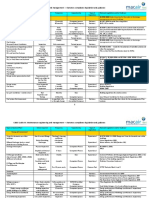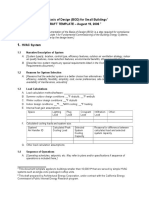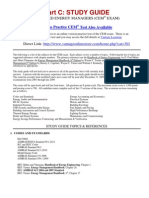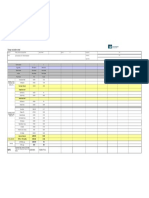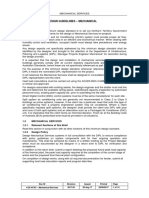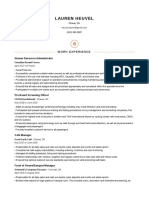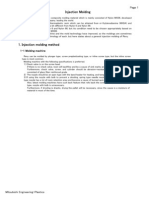0 ratings0% found this document useful (0 votes)
124 viewsDetailed HAP Load Calculation Fixed
Uploaded by
Kamran TasadoghCopyright
© © All Rights Reserved
Available Formats
Download as PDF, TXT or read online on Scribd
0 ratings0% found this document useful (0 votes)
124 viewsDetailed HAP Load Calculation Fixed
Uploaded by
Kamran TasadoghCopyright
© © All Rights Reserved
Available Formats
Download as PDF, TXT or read online on Scribd
You are on page 1/ 3
Detailed Guide to Cooling, Heating, and Fresh Air Load Calculations
1. Cooling Load Calculation
Cooling load involves calculating the heat gain from various sources, which is then removed to
maintain a desired indoor temperature. Key components include:
- Sensible Heat: Heat from walls, roofs, windows, and internal equipment.
- Latent Heat: Heat from moisture due to occupants or infiltration.
- Solar Heat Gain: Sunlight entering through windows or skylights.
Steps to calculate cooling load:
1. Define the space dimensions and layout.
2. Input external heat gains (walls, windows, roofs).
- Use ASHRAE tables for U-values (thermal transmittance).
- Calculate Q = U x A x Delta T for each surface.
3. Input internal heat gains (occupants, lighting, equipment).
- Use standard values for heat gain per occupant and wattage for lighting.
4. Include ventilation and infiltration loads.
- Calculate fresh air requirements based on standards like ASHRAE 62.1.
- Q_vent = 1.08 x CFM x Delta T (sensible) + 0.68 x CFM x Delta W (latent).
5. Sum all components to determine total cooling load.
2. Heating Load Calculation
Heating load calculation focuses on heat loss through building envelopes and the energy required to
maintain desired indoor temperatures.
Steps to calculate heating load:
1. Input thermal characteristics of walls, windows, and roofs.
- Calculate Q = U x A x Delta T for each surface.
2. Include infiltration heat loss.
- Use the formula Q_infil = CFM x 1.08 x Delta T.
3. Sum up all components to determine total heating load.
4. Account for additional losses, such as uninsulated pipes or ducts.
3. Fresh Air Load Calculation
Fresh air load depends on the ventilation requirements, typically calculated per ASHRAE 62.1 or
local standards.
Steps:
1. Determine ventilation rate based on occupancy type (e.g., office, residential).
- Example: For an office, 15-20 CFM per person.
2. Calculate sensible and latent loads for fresh air.
- Sensible Load: Q_sensible = 1.08 x CFM x Delta T.
- Latent Load: Q_latent = 0.68 x CFM x Delta W.
(Delta T = Temperature difference, Delta W = Humidity ratio difference.)
3. Add these to the total cooling or heating load.
4. Advanced Load Components
- Infiltration: Account for air leakage through doors, windows, and cracks.
- Solar Gains: Use shading coefficients for windows to reduce load.
- Heat Recovery: Incorporate energy recovery systems to minimize fresh air impact.
5. Practical Example
Example:
Consider a 1000 sq.ft. office with 10 occupants:
1. Calculate external heat gain (walls, windows, roof).
2. Add internal gains (occupants: 400 BTU/hr each, lighting: 2 W/sq.ft.).
3. Determine fresh air load for 20 CFM/person.
- Q_sensible = 1.08 x (20 x 10) x 20 = 4,320 BTU/hr.
- Q_latent = 0.68 x (20 x 10) x 0.005 = 68 BTU/hr.
4. Sum up for total load: Cooling = External + Internal + Fresh Air.
You might also like
- Full download Energy Audit of Building Systems: An Engineering Approach, 3rd Edition Krarti pdf docx100% (6)Full download Energy Audit of Building Systems: An Engineering Approach, 3rd Edition Krarti pdf docx40 pages
- Commissioning Chilled Water Systems From Design To OccupancyNo ratings yetCommissioning Chilled Water Systems From Design To Occupancy75 pages
- Hope 4.8L-C1 - RESS - Quick - Guidance - 20210429No ratings yetHope 4.8L-C1 - RESS - Quick - Guidance - 2021042916 pages
- Chapter 8: Using The Discrete Ordinates Radiation ModelNo ratings yetChapter 8: Using The Discrete Ordinates Radiation Model44 pages
- 235-Custom Air Handling Unit Submittal (For Record) - Record Purpose Shop Drawings - 2017-02-03-115802 PDFNo ratings yet235-Custom Air Handling Unit Submittal (For Record) - Record Purpose Shop Drawings - 2017-02-03-115802 PDF173 pages
- Earth & Life Science Q1 Module 2 - DESIREE VICTORINO50% (4)Earth & Life Science Q1 Module 2 - DESIREE VICTORINO22 pages
- Absorption Cooling Systems - Review of VariousNo ratings yetAbsorption Cooling Systems - Review of Various32 pages
- CIBSE Guide M: Maintenance Engineering and Management - Statutory Compliance Legislation and GuidanceNo ratings yetCIBSE Guide M: Maintenance Engineering and Management - Statutory Compliance Legislation and Guidance6 pages
- Evaporative Cooler Sizing Calculator Sheet 1No ratings yetEvaporative Cooler Sizing Calculator Sheet 11 page
- Hitachi Inverter-Driven Multi-Split System Heat Pump Air ConditionersNo ratings yetHitachi Inverter-Driven Multi-Split System Heat Pump Air Conditioners291 pages
- Carrier Light Commercial Air Conditioner Split UnitNo ratings yetCarrier Light Commercial Air Conditioner Split Unit14 pages
- Architect / Consultant Sandeep Govalkar Design Associates Client: Central Bank of India Project: - Proposed Air Conditioning Work of Vikhroli BranchNo ratings yetArchitect / Consultant Sandeep Govalkar Design Associates Client: Central Bank of India Project: - Proposed Air Conditioning Work of Vikhroli Branch2 pages
- Design Calculation Sheet: PEARL QATAR Facility MGT (Q07048) A.B Checked By: N.E Approved byNo ratings yetDesign Calculation Sheet: PEARL QATAR Facility MGT (Q07048) A.B Checked By: N.E Approved by1 page
- A 9 D 15 1297776657222 Euroconfort Ciat New Space PF BTNo ratings yetA 9 D 15 1297776657222 Euroconfort Ciat New Space PF BT8 pages
- Electronic Wind Catcher - (Al-Malqaf) : As A New Way To Solve Identity and Energy DilemmasNo ratings yetElectronic Wind Catcher - (Al-Malqaf) : As A New Way To Solve Identity and Energy Dilemmas59 pages
- Method Statement: Peak Load Testing Procedure For ChillerNo ratings yetMethod Statement: Peak Load Testing Procedure For Chiller5 pages
- Geothermal HVAC - : Exceeding ASHRAE Standards at Lowest Life Cycle CostNo ratings yetGeothermal HVAC - : Exceeding ASHRAE Standards at Lowest Life Cycle Cost11 pages
- Mechanical Services HVAC Design MES v2017.05No ratings yetMechanical Services HVAC Design MES v2017.0514 pages
- Tutorial For HVAC in AutoCAD MEP - PDF CourseNo ratings yetTutorial For HVAC in AutoCAD MEP - PDF Course96 pages
- Current Therapy of Trauma and Surgical Critical CareNo ratings yetCurrent Therapy of Trauma and Surgical Critical Care4 pages
- How To Purify Water - Water Purification ProcessNo ratings yetHow To Purify Water - Water Purification Process3 pages
- Procurement Workshop Invite 8th April 2013 PDFNo ratings yetProcurement Workshop Invite 8th April 2013 PDF2 pages
- Self-Discipline Worksheets: Welcome To "Building Great Character"No ratings yetSelf-Discipline Worksheets: Welcome To "Building Great Character"4 pages
- Quality Indicators For Blood EstablishmentsNo ratings yetQuality Indicators For Blood Establishments2 pages
- Occupational Therapy Practice in Sleep Management100% (1)Occupational Therapy Practice in Sleep Management13 pages
- Cargo Ventilation System On Liquefied Gas CarriersNo ratings yetCargo Ventilation System On Liquefied Gas Carriers19 pages
- Rendezvous With John Frawley The Real AstrologyNo ratings yetRendezvous With John Frawley The Real Astrology10 pages
- PDF Wildlife Toxicology Emerging Contaminant and Biodiversity Issues 1st Edition Ronald J Kendall download100% (2)PDF Wildlife Toxicology Emerging Contaminant and Biodiversity Issues 1st Edition Ronald J Kendall download67 pages













